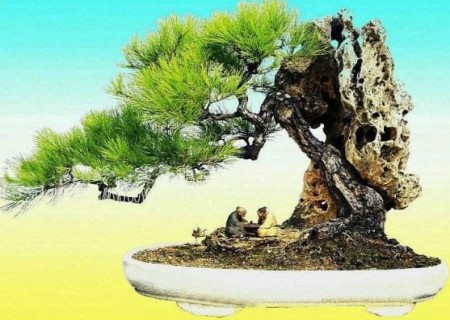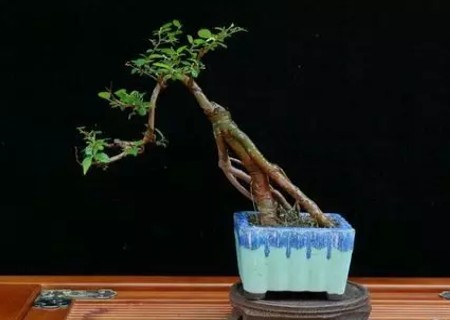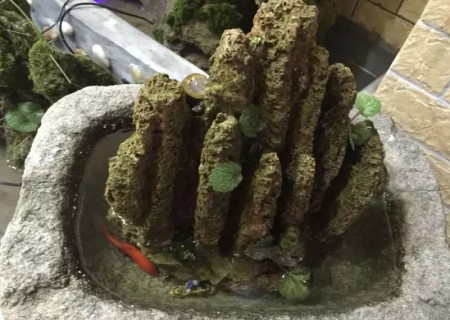Illustration of the steps of making stone bonsai
In general, the pile scene is to plant the stump directly in the basin soil, and its production and maintenance are relatively easy. If the stump is like a stone and grows on a stone, it will be a stone-attached pile scene with special interest. There are many kinds of ornamental stones, but the hard, non-absorbent rocks are generally not used, otherwise it is not easy to process, even if made, maintenance is also difficult. Therefore, to do stone-attached pile scene, we must choose soft rocks that are easy to absorb water, such as sand stone, Reed stone, pumice and so on.

There are two specific practices:
One is to carve a cave from the waist or top of the rock to its inner part, and when carving, try to make the mouth and abdomen as big as a bottle, and then slowly put into the cultivation soil, while putting into the fibrous root of the stump and constantly stirring, do not make the pile root curl up, to make the root and soil close, it is best to slightly modify the shape of the rock, and flatten the bottom of the rock. At this time, you can put it into a shallow basin filled with water, a basin with mountains and water, and the water-attached bonsai protruding from the rock is completed. If the bonsai is dry and attached to stone, the basin will hold soil without water, and the stump can be chiseled up and down so that the stump can pass through the cave. Part of the root grows in the soil of the cave, and most of the root still grows in the soil. From the location, it seems that the stump has grown from the stone.
Another method is to carve several to more than a dozen grooves on each side of the rocks, the direction of the grooves is either straight or oblique, and the spacing is the same, and the depth and width of the grooves should depend on the thickness of the tall tree roots. After the rock grooves are finished, soak them in water for several days. Then the side roots of the stump are embedded in the grooves of the rocks one by one, and the edges are temporarily fixed with adhesive tape. After the root grooves are finished, the periphery is finally fixed with a few circles of fine lead wire, and the adhesive tape is removed.
Then seal the roots and rocks with river mud or thick pulp, and then wrap them with moss. The fine root part of the root tip must still be straightened out and planted in the potted soil, and then the moss can be removed after about a year of careful maintenance. After another year of maintenance, the river mud on the surface of the stone root is gradually washed clean due to watering and rain, at this time the tree root has been close to the rock, and the original fixed copper wire can also be removed.
With the growth and adaptation of the stump, the roots gradually grow and thick. although the main absorption parts of the roots grow in the basin soil, the roots grow tenaciously like dragon claws, which is very powerful, beautiful in shape and profound in meaning.
What we are going to show today is the production process of stone bonsai.
1. Above is the material to be made, a small banyan tree and a selected stone.
2. Choose a basin of the right size, put a small amount of soil at the bottom, and put the stone in.
3. Then remove the banyan tree from the basin, pick up the soil carefully and be careful not to hurt the roots.
4. After observation, put the banyan tree in the right position.
5. Fix the roots and embed them into grooves and caves in the stone.
6. Fix the roots of each part with thin aluminum wire. Hemp thread can also be used. The advantage of hemp thread is that it will rot over time and will not leave ligature marks on the roots.
7. Fixed.
8. Perimeter fence.
9. Fill the fence with soil and pour water through it.
Stone-attached bonsai reflects the natural style of trees growing on rocks. It is an exaggeration and close-up of trees tenaciously growing in cliff gaps or peaks and rocks. It is rich in content and profound in artistic conception. At the same time, it can also make up for the natural defects of some bonsai trees (such as bonsai wood with too high trunk), and it is also a form loved by bonsai lovers.
The stone-attached bonsai plants the trees between the stones, the root system extends into the stone cracks, and the branches bend into the stone caves-- or clusters on the stone, or under the overhanging stone, or horizontally near the stone, so that the strange stone and the ancient tree reflect each other. It has the advantages of beautiful shape, exquisite conception, various forms, simple production, easy to master, short training cycle, and is favored by the public.
Time: 2019-06-03 Click:
- Prev

How to make miniature bonsai
Miniature potted plants to flowers and plants mainly, decorated with small pieces such as rocks configuration. It mostly uses stone hedgerow, asparagus, saxifraga, spider orchid, orchid, evergreen, narcissus, chrysanthemum, banana, reed and other idle weeds. Miniature bonsai focuses on small shape, exquisite and unique shape, and pays more attention to the connotation of overall artistic beauty.
- Next

How to make Sheung Shui Stone Bonsai
Shangshui stone bonsai is mainly a beautiful landscape composed of rocks and plants, which is further made and perfected on the basis of landscape bonsai. On the other hand, there are more materials for making Shangshui stone bonsai, which are mostly obtained in nature, and the bonsai produced is more natural. So, how to make Shangshui stone bonsai?
Related
- Fuxing push coffee new agricultural production and marketing class: lack of small-scale processing plants
- Jujube rice field leisure farm deep ploughing Yilan for five years to create a space for organic food and play
- Nongyu Farm-A trial of organic papaya for brave women with advanced technology
- Four points for attention in the prevention and control of diseases and insect pests of edible fungi
- How to add nutrient solution to Edible Fungi
- Is there any good way to control edible fungus mites?
- Open Inoculation Technology of Edible Fungi
- Is there any clever way to use fertilizer for edible fungus in winter?
- What agents are used to kill the pathogens of edible fungi in the mushroom shed?
- Rapid drying of Edible Fungi

